英语语法详解ed分词(三)
高中英语语法非谓语动词

非谓语动词一、动词的-ed形式1.动词-ed形式作状语(1)动词-ed形式作状语,进一步说明谓语动词的动作或状态,其逻辑主语通常就是句子的主语。
Used with care, one tin will last for six weeks.Translated into English, the sentence was found to have an entirely different word order.(2)某些动词的过去分词已经形容词化,此时这些过去分词表示一种状态。
这样的词(组)常见的有:lost (迷路的), seated (坐), hidden (躲), stationed (驻扎), lost/absorbed in (沉溺于), dressed in (穿着), tired of (感到厌倦)等。
Absorbed in his book, he didn’t notice me enter the room.2.动词-ed形式作定语动词-ed形式(短语)作定语与它所修饰的名词之间在逻辑上存在被动关系,并表示该动作的被动或完成。
Tsinghua University, founded in 1911, is home to a great number of outstanding figures.3.动词-ed形式作宾语补足语动词-ed形式作宾语补足语时,句中的宾语往往就是其逻辑主语,该动词与宾语之间存在动宾关系。
Michael put up a picture of Yao Ming beside the bed to keep himself reminded of his own dreams.4.动词-ed形式作表语动词-ed形式作表语时,大多数是已经形容词化的过去分词。
如:seated, disappointed, stuck, excited等。
In April, thousands of holidaymakers remained stuck abroad due to the volcanic ash cloud.二、动词的-ing形式1.动词-ing形式作状语(1)动词的-ing形式作状语表示在进行一动作的同时所进行的另一动作,它对谓语动词起修饰和陪衬的作用。
动词ed形式
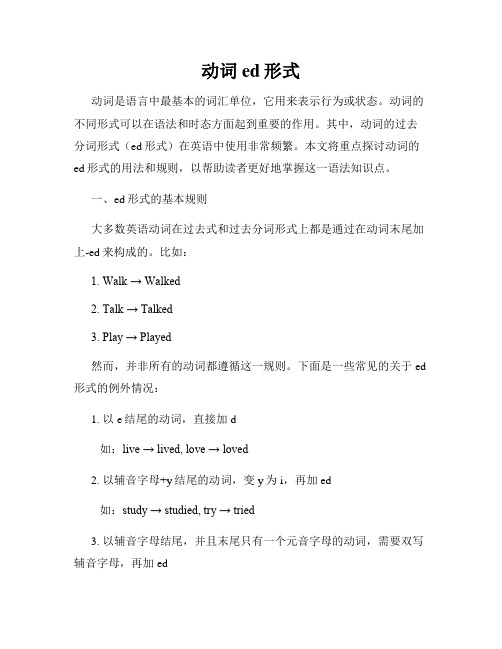
动词ed形式动词是语言中最基本的词汇单位,它用来表示行为或状态。
动词的不同形式可以在语法和时态方面起到重要的作用。
其中,动词的过去分词形式(ed形式)在英语中使用非常频繁。
本文将重点探讨动词的ed形式的用法和规则,以帮助读者更好地掌握这一语法知识点。
一、ed形式的基本规则大多数英语动词在过去式和过去分词形式上都是通过在动词末尾加上-ed来构成的。
比如:1. Walk → Walked2. Talk → Talked3. Play → Played然而,并非所有的动词都遵循这一规则。
下面是一些常见的关于ed 形式的例外情况:1. 以e结尾的动词,直接加d如:live → lived, love → loved2. 以辅音字母+y结尾的动词,变y为i,再加ed如:study → studied, try → tried3. 以辅音字母结尾,并且末尾只有一个元音字母的动词,需要双写辅音字母,再加ed如:stop → stopped, plan → planned二、ed形式的常见用法1. 表示过去发生的动作或状态Mary walked to the park yesterday.(玛丽昨天步行去了公园。
)The house was painted last summer.(那所房子是去年夏天油漆的。
)2. 作为及物动词的过去分词形式Tom has finished his homework.(汤姆已经做完作业了。
)The book has been read by millions of people.(这本书已经被数百万人阅读过。
)3. 作为形容词的用法He looked excited when he heard the news.(听到那个消息时,他看起来很兴奋。
)The broken window needs to be fixed.(那个破窗户需要修理。
)4. 作为省略从句中的被动语态She was given a gift by her friend.(她得到了朋友的礼物。
高中英语语法专题第十五章 动词的-ed分词

第十五章动词的-ed分词-ed分词即传统语法中所说的过去分词,它也是一种非谓语动词。
一、-ed分词的句法功能(一)作定语作定语的-ed分词如果是单词,一般放在它所修饰的名词前面,它表示被动和完成,而-ing形式作前置定语则表示主动和进行含义。
比较:boiled water开水 boiling water沸腾的水frozen food 冷冻食品 a freezing wind刺骨寒风developed countries 发达国家 developing countries发展中国家-ed分词短语作定语,要放在它所修饰的名词后面。
如:He started a new programme called "communism".他提出一项称之为"共产主义"的新纲领。
People developed a kind of paper made from the fibres of plants.人们研制出一种用植物纤维制成的纸。
This is one of the houses built last year.这是去年建的一所房子。
(二)做宾语补足语在某些动词如hear,see,make,find,keep等后可用-ed分词作宾补,表示一个被动的已完成的动作。
如:What should you do if you find a person trapped under a car?如果发现有人被压在车下,你该怎么办?I found all the windows broken.我发现所有的窗子都被打破了。
[注意]“have/get sth.+-ed分词作宾补”的不同含义“have/get sth.+-ed分词作宾补”归纳起来有3种不同含义:1.表示让/叫别人(为自己)做某事。
如:He's going to have his hair cut.他要去理发。
She had her house repaired.她(请人)修理了房屋。
英语语法详解 动词ed形式的构成和用法

英语语法详解动词ed形式的构成和用法动词-ed形式的构成:由动词原形+ed构成(也有一些动词为不规则动词),也称为动词的过去分词。
动词-ed形式仍保留着动词的特征,可以跟宾语和状语。
I'd like the problem solved quickly. 我希望这个问题能尽快解决。
(带有自己的状语)Offered more opportunities, he could have done it better. 如果提供给他更多的机会,他可能会做得更好。
(带有自己的宾语)动词-ed形式的否定形式:由not/never+动词-ed形式构成。
Not watered in time, the flowers withered. 没有及时浇水,花朵枯萎了。
动词-ed形式的含义:一般及物动词的-ed形式表示完成的和被动的动作;不及物动词的-ed 形式只表示完成,不表被动。
With all the things bought, he went home happily. 东西都买齐了,他高高兴兴地回家了。
(表被动表完成)Autumn is coming, and the ground is full of fallen leaves. 秋天来了,地上满是落叶。
(表完成)动词-ed形式的用法动词-ed形式具有动词,形容词和副词的特征,在句中可以作定语,表语,状语,补语。
1.动词-ed形式作定语动词-ed形式作定语既可以放在所修饰名词的前面,称为前置定语,也可以放在所修饰名词的后面,称为后置定语。
单个的动词-ed形式作定语一般放在所修饰名词的前面(少数单个动词-ed形式作定语放在所修饰名词的后面,如left);而动词-ed形式的短语作定语一般放在所修饰名词的后面。
The disappointed look on her face suggested she was very sad. 她脸上失望的表情表明她很伤心。
考研英语语法分词解析(三)中公考研
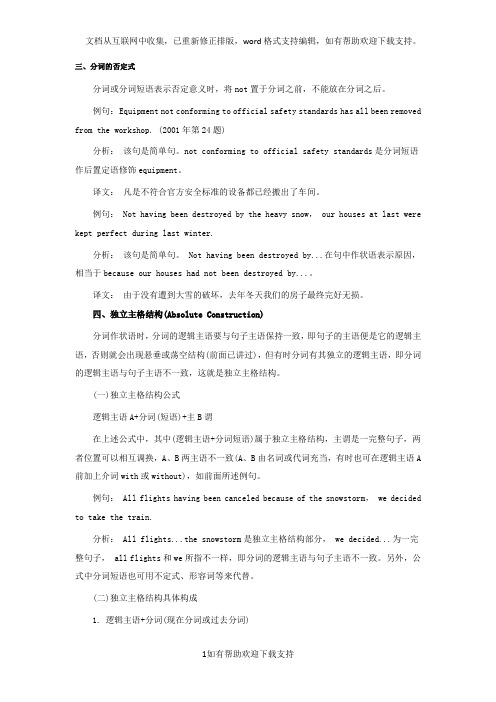
三、分词的否定式分词或分词短语表示否定意义时,将not置于分词之前,不能放在分词之后。
例句: Equipment not conforming to official safety standards has all been removed from the workshop. (2001年第24题)分析:该句是简单句。
not conforming to official safety standards是分词短语作后置定语修饰equipment。
译文:凡是不符合官方安全标准的设备都已经搬出了车间。
例句: Not having been destroyed by the heavy snow, our houses at last were kept perfect during last winter.分析:该句是简单句。
Not having been destroyed by...在句中作状语表示原因,相当于because our houses had not been destroyed by...。
译文:由于没有遭到大雪的破坏,去年冬天我们的房子最终完好无损。
四、独立主格结构(Absolute Construction)分词作状语时,分词的逻辑主语要与句子主语保持一致,即句子的主语便是它的逻辑主语,否则就会出现悬垂或荡空结构(前面已讲过),但有时分词有其独立的逻辑主语,即分词的逻辑主语与句子主语不一致,这就是独立主格结构。
(一)独立主格结构公式逻辑主语A+分词(短语)+主B谓在上述公式中,其中(逻辑主语+分词短语)属于独立主格结构,主谓是一完整句子,两者位置可以相互调换,A、B两主语不一致(A、B由名词或代词充当,有时也可在逻辑主语A 前加上介词with或without),如前面所述例句。
例句: All flights having been canceled because of the snowstorm, we decided to take the train.分析: All flights...the snowstorm是独立主格结构部分, we decided...为一完整句子, all flights和we所指不一样,即分词的逻辑主语与句子主语不一致。
高中英语语法知识点 -ed分词

考点18 -ed分词高考频度:★★★★★规则动词的过去分词一般是由动词加ed构成(具体规则见后),不规则动词的过去分词见不规则动词表。
过去分词则属于类动词1. 及物动词的过去分词作表语,与句子主语是被动关系,表示主语的状态,不但表示被动,还表示已完成了。
The cup is broken. 茶杯破了。
2. 不及物动词的过去分词作表语,与句子主语是主动关系,表示主语的状态,只表示动作的完成。
He is retired. 他已退休。
3. 有些过去分词作表语时,构成的谓语很接近被动结构。
考向一过去分词作定语作定语用的过去分词相当于形容词,其逻辑主语就是它所修饰的名词。
过去分词作定语分为前置和后置两种情况。
1.前置定语单个的过去分词作定语,通常放在被修饰的名词之前。
由及物动词转化而来的过去分词作定语,表示"被动和完成"含义,或只具有"被动"含义;由不及物动词转化而来的过去分词作定语,只表"完成"含义。
(1)被动和完成含义:☞We must adapt our thinking to the changed conditions.我们必须使我们的思想适应改变了的情况。
(2)被动含义:☞She is a respected teacher.她是一位受人尊敬的老师。
(3)完成含义:☞They are cleaning the fallen leaves in the yard.他们正在打扫院子里的落叶。
2.后置定语过去分词短语作定语时,通常放在所修饰的名词之后,它的作用相当于一个定语从句。
☞This will be the best novel of its kind ever written (=that has ever been written).这将是这类小说中写得最好的。
☞Who were the socalled guests invited (=who had been invited) to your party last night?昨晚被邀请参加你的晚会的那些所谓的客人是谁呀?☞Yesterday I bought a book published by Foreign Language Teaching and Research Press.昨天我买了一本外语教学与研究出版社出版的书。
ed分词英语语法详解
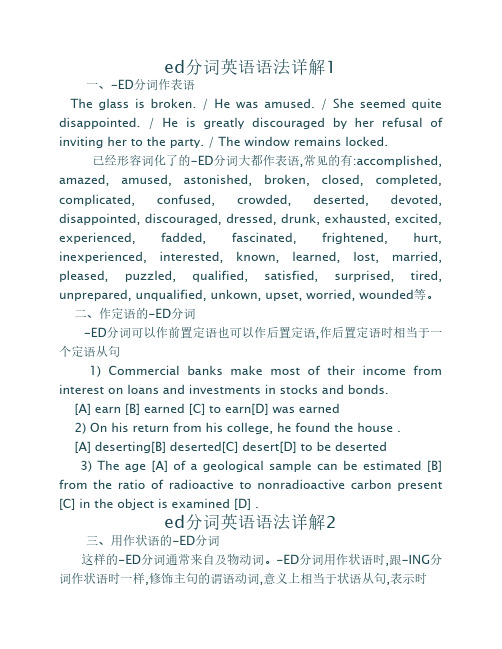
ed分词英语语法详解1一、-ED分词作表语The glass is broken. / He was amused. / She seemed quite disappointed. / He is greatly discouraged by her refusal of inviting her to the party. / The window remains locked.已经形容词化了的-ED分词大都作表语,常见的有:accomplished, amazed, amused, astonished, broken, closed, completed, complicated, confused, crowded, deserted, devoted, disappointed, discouraged, dressed, drunk, exhausted, excited, experienced, fadded, fascinated, frightened, hurt, inexperienced, interested, known, learned, lost, married, pleased, puzzled, qualified, satisfied, surprised, tired, unprepared, unqualified, unkown, upset, worried, wounded等。
二、作定语的-ED分词-ED分词可以作前置定语也可以作后置定语,作后置定语时相当于一个定语从句1) Commercial banks make most of their income from interest on loans and investments in stocks and bonds.[A] earn [B] earned [C] to earn[D] was earned2) On his return from his college, he found the house .[A] deserting[B] deserted[C] desert[D] to be deserted3) The age [A] of a geological sample can be estimated [B] from the ratio of radioactive to nonradioactive carbon present [C] in the object is examined [D] .ed分词英语语法详解2三、用作状语的-ED分词这样的-ED分词通常来自及物动词。
初三英语中考语法考点重难点解读指导(二十八)ing分词和ed分词总结整理
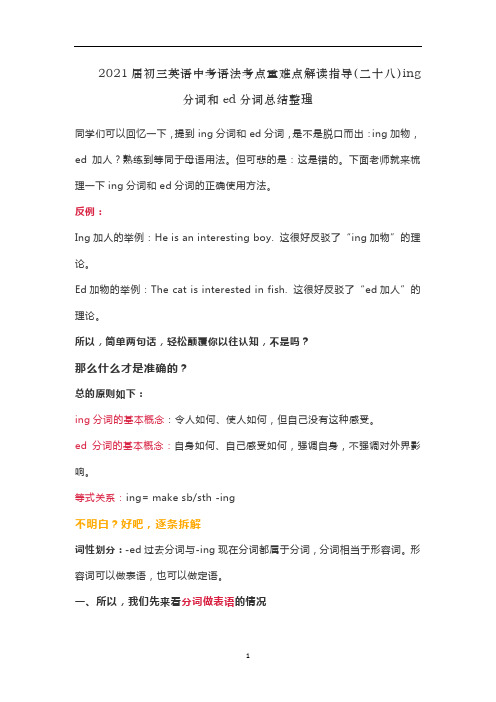
2021届初三英语中考语法考点重难点解读指导(二十八)ing分词和ed分词总结整理同学们可以回忆一下,提到ing分词和ed分词,是不是脱口而出:ing加物,ed加人?熟练到等同于母语用法。
但可悲的是:这是错的。
下面老师就来梳理一下ing分词和ed分词的正确使用方法。
反例:Ing加人的举例:He is an interesting boy. 这很好反驳了“ing加物”的理论。
Ed加物的举例:The cat is interested in fish. 这很好反驳了“ed加人”的理论。
所以,简单两句话,轻松颠覆你以往认知,不是吗?那么什么才是准确的?总的原则如下:ing分词的基本概念:令人如何、使人如何,但自己没有这种感受。
ed分词的基本概念:自身如何、自己感受如何,强调自身,不强调对外界影响。
等式关系:ing= make sb/sth -ing不明白?好吧,逐条拆解词性划分:-ed过去分词与-ing现在分词都属于分词,分词相当于形容词。
形容词可以做表语,也可以做定语。
一、所以,我们先来看分词做表语的情况1. -ed 形容词用来表示主语本身所具有的某种主观感受。
同时,要求主语本身具有主观判断力。
主语一般为人、动物,基本不包括植物以及无生命事物(除非是童话故事、神话故事)。
举例:•I’m satisfied with your answer.•He is not interested in research.•The pupils will get confused if they are made to learn too much.•They were very excited at the news.正因为如此,feel这个半系动词后面,必须加ed分词。
即Feel 作为感官动词,后面一律用-ed 分词。
2. -ing 形容词用来表示主语本身不具备没有主观感受,而是客观上给外界带来的感受。
主语可以是人,动物,植物,以及无生命事物。
英语语法与词汇详解 动名词和分词

英语语法与词汇详解动名词和分词一、分词(现在分词和过去分词)1、分词短语作定语现在分词作定语一般表示正在进行的动作,即用来叙述和谓语动词差不多同时发生的动作,而过去分词短语作定语时一般表示被动或完成了的动作。
->例子:The famous Times Square street entertainer is renowned for singing wearing little more than cowboy boots, a hat and a strategically placed guitar.[这位著名的时代广场街头艺人以“凉爽穿着”而闻名,标志穿着包括一双牛仔马靴和一顶牛仔帽,当然,还有一把“举足轻重”的吉他。
]2、分词短语作状语分词短语作状语时,可表示时间、原因、条件、伴随、方式或结果等。
此时如果分词表示的动作与句子的主语之间有主谓关系,即分词的动作由主语发出,用现在分词形式;如果分词表示的动作与句子的主语之间有动宾关系,即句子的主语是分词动作的承受者,分词采用过去分词形式。
->例子:People can even get a computer by which to control the contraption, making the teeth change colors or even blink.[人们还可通过电脑远程控制该装置,使得牙齿变色甚至不断闪烁。
]3、带连词的分词短语作状语分词短语可用在after, before, when, while, when, ever, once,until, if, as if等之后。
->例子:French skyscraper climber Alain Robert scaled a 31-floor office building outside Paris on Wednesday using only his bare hands, his last climb before spending a weekin prison in Texas.[本周三,法国摩天大楼攀登高手阿兰·罗伯特徒手爬上位于巴黎近郊一幢31层的办公大楼。
关于英语-ed分词和-ing分词,这 5 个语法要点经常考.doc
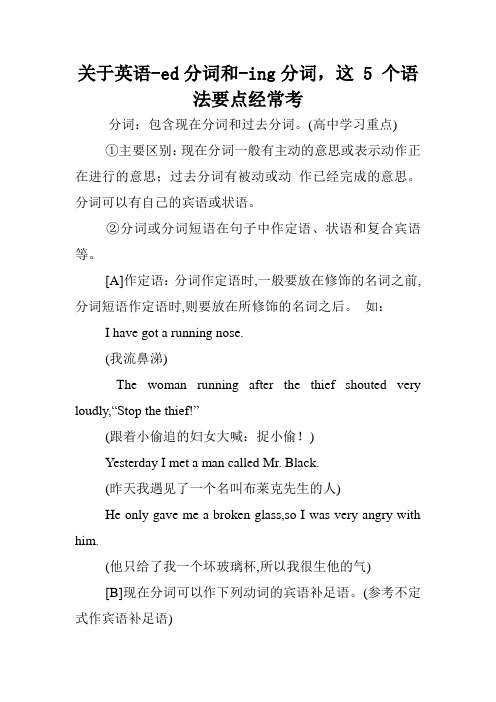
关于英语-ed分词和-ing分词,这 5 个语法要点经常考分词:包含现在分词和过去分词。
(高中学习重点)①主要区别:现在分词一般有主动的意思或表示动作正在进行的意思;过去分词有被动或动作已经完成的意思。
分词可以有自己的宾语或状语。
②分词或分词短语在句子中作定语、状语和复合宾语等。
[A]作定语:分词作定语时,一般要放在修饰的名词之前,分词短语作定语时,则要放在所修饰的名词之后。
如:I have got a running nose.(我流鼻涕)The woman running after the thief shouted very loudly,“Stop the thief!”(跟着小偷追的妇女大喊:捉小偷!)Yesterday I met a man called Mr. Black.(昨天我遇见了一个名叫布莱克先生的人)He only gave me a broken glass,so I was very angry with him.(他只给了我一个坏玻璃杯,所以我很生他的气)[B]现在分词可以作下列动词的宾语补足语。
(参考不定式作宾语补足语)谓语动词(vt.)宾语宾语补足语keep(保持) /see(看到) /hear(听到) /watch(注意到) /feel(感觉到)sb./sth.(do)ing如:Mum kept me working all the week.(妈妈让我一个星期都在工作)When I entered the room,I saw Jack eating a big pear.(我进入房间时看到杰克正在吃一只大梨子)In the dark I felt something very cold moving on my foot.(黑暗之中我感到有个冷的东西在我的脚上移动)[C]现在分词可以作状语,表示伴随情况。
如:She came into the classroom,holding a pile of papers in her hand.(他走进教室,手上抓着一沓纸)I am very busy these days getting ready for the coming oral test.(这些日子我正忙着准备即将来到的口语考试)[D]过去分词可以作表语,放在连系动词后面,但要注意不要与被动语态混淆,“主系表”主要表示状态,而被动语态则表示动作。
英语语法系列之过去分词【知识梳理】【知识梳理】1 定义动词的ed分词即过去分词

内容英语语法系列之过去分词【知识梳理】【知识梳理】1. 定义动词的ed分词即过去分词英语语法系列之过去分词【知识梳理】1. 定义:动词的ed分词即过去分词,是由动词的过去分词构成,一般只有一种形式。
2. 过去分词的语法作用:过去分词一方面具有动词的性质,另一方面也相当于一个形容词或副词,在句中可以作表语、定语、状语和补足语。
1)过去分词作表语,主要表示主语的心理感觉或所处的状态。
如:Don’t touch the glass because it is broken. 不要碰那个杯子,它是坏的。
He is quite pleased with the design of the dress. 她很喜欢那礼服的式样。
2)过去分词做定语:单个的过去分词作定语一般放在名词的前面,相当于一个定语从句。
如:The excited people rushed into the building. 激动的人们奔进了大楼。
过去分词短语作定语通常放在被修饰的词后面,相当于一个定语从句。
Is there anything planned f tomrow 明天有什么活动吗过去分词作定语也可用作非限制性定语,前后用逗号隔开。
如:The meeting attended by one thous students was a success.这次会议获得很大的成功,共有一千个学生出席了。
3)过去分词做状语:过去分词和ing分词作状语一样,也可以表示时间、原因、条件、让步、方式或伴随情况等。
①表时间,相当于一个时间状语从句,有时过去分词前可加连词when或while来强调时间概念。
如:Seen from the top of the hill the city looked like a big garden. 从山顶上看,这个城市就像一个大花园。
②表原因,相当于一个原因状语从句。
如:Deeply moved by the sty the excited people stopped quarrelling with each other.激动的人们被那个故事深深地感动了,停止了争吵。
过去分词英语语法详细分析

过去分词英语语法详细分析一. 分词的定义动词的-ed分词即过去分词,是由动词的过去分词构成,一般只有一种形式。
二. 过去分词的语法作用:过去分词一方面具有动词的性质,另一方面也相当于一个形容词或副词,在句中可以作表语、定语、状语和补足语。
1) 过去分词作表语,主要表示主语的心理感觉或所处的状态。
如:Don’t touch the glass because it is broken. 不要碰那个杯子,它是坏的。
He is quite pleased with the design of the dress. 她很喜欢那礼服的式样。
2) 过去分词做定语:单个的过去分词作定语一般放在名词的前面,相当于一个定语从句。
如:The excited people rushed into the building. 激动的人们奔进了大楼。
We need more qualified teachers. 我们需要更多合格的教师。
过去分词短语作定语通常放在被修饰的词后面,相当于一个定语从句。
如:Is there anything planned for tomorrow? 明天有什么活动吗?The suggestion made by the foreign expert was adopted by the manager. 外国专家提出来的建议被经理采纳了。
过去分词作定语也可用作非限制性定语,前后用逗号隔开。
如:The books, written by Lu Xun, are popular with many Chinese people.这些书是鲁迅写的,受到了许多中国人民的喜爱。
The meeting, attended by one thousand students, was a success. 这次会议获得很大的成功,共有一千个学生出席了。
3) 过去分词做状语:过去分词和-ing分词作状语一样,也可以表示时间、原因、条件、让步、方式或伴随情况等。
初中英语语法—句子成分详解(11)

初中英语语法—句子成分详解英语句子成分分为7种:主语、谓语、宾语、定语、状语、表语、补语。
(一)主语主语是句子陈述的对象,说明是谁或什么。
表示句子说的是“什么人”或“什么事”。
主语是执行句子的行为或动作的主体。
主语可以用这些词类或形式来担任:名词、代词、动名词或现在分词、数词、动词不定式或不定式短语、从句等。
作主语的各种成分:1.名词作主语Our school is not far from my house. 我们的学校离我家不远。
2.代词作主语We like our school very much. 我们非常喜欢我们学校。
3数词作主语Two plus two is four. 二加二等于四。
4.动名词作主语Seeing is believing. 眼见为实。
5.动词不定式作主语To do such a job needs a better knowledge. 做这样一份工作需要丰富的知识。
6.从句作主语What I mean is to work harder. 我的意思是要努力工作。
*注意:为了保持句子平衡,通常将较长的部分(不定式、动名词、从句)移至句末而在原主语位置使用形式主语it,真正的主语是后面的部分。
作形式主语的代词只能用it,不能用that,this 等词。
如:It made us very happy that she was saved. = That she was saved made us very happy.她能化险为夷令我们大家很高兴。
(二)谓语1.谓语是对主语动作或状态的陈述或说明,指出“做什么”“是什么”或“怎么样”,谓语动词的位置一般在主语之后。
谓语动词一般由动词的各种时态来体现。
如:I like walking. 我喜欢走路。
(一般现在时主动语态)I made your birthday cake last night. 昨晚我做好了你的生日蛋糕。
(一般过去时主动语态)It is used by travelers and businessmen all over the world. 全世界的旅行者和商人都使用它。
ed分词英语语法详解

ed分词英语语法详解1一、-ED分词作表语The glass is broken. / He was amused. / She seemed quite disappointed. / He is greatly discouraged by her refusal of inviting her to the party. / The window remains locked.已经形容词化了的-ED分词大都作表语,常见的有:accomplished, amazed, amused, astonished, broken, closed, completed, complicated, confused, crowded, deserted, devoted, disappointed, discouraged, dressed, drunk, exhausted, excited, experienced, fadded, fascinated, frightened, hurt, inexperienced, interested, known, learned, lost, married, pleased, puzzled, qualified, satisfied, surprised, tired, unprepared, unqualified, unkown, upset, worried, wounded等。
二、作定语的-ED分词-ED分词可以作前置定语也可以作后置定语,作后置定语时相当于一个定语从句1) Commercial banks make most of their income from interest on loans and investments in stocks and bonds.[A] earn [B] earned [C] to earn[D] was earned2) On his return from his college, he found the house .[A] deserting[B] deserted[C] desert[D] to be deserted3) The age [A] of a geological sample can be estimated [B] from the ratio of radioactive to nonradioactive carbon present [C] in the object is examined [D] .ed分词英语语法详解2三、用作状语的-ED分词这样的-ED分词通常来自及物动词。
强烈推荐-ed分词系表结构和被动语态的区别(英语语法)

-ed分词系表结构和被动语态的区别-ed分词这个结构在英语表达中是常见的。
它既可以是系表结构,又可以是被动语态。
因此,我们可以称之为静动句的混合体。
静句是用来描写事物的性质或状态的。
动句是用来描写动作及动作过程。
由于在表达形式上这两种结构是一样的,都由be +ed分词构成,这样就给区别系表结构和被动语态带来了麻烦。
现将几种区别方法归纳如下:一.从动词的性质来区分英语中的不及物动词不用于被动语态。
但是,不及物动词的过去分词可以和动词be连用构成系表结构。
在这个结构中,过去分词只表示动作已经完成。
强调事物的状态。
常见的这种形式不及物动词有:gone,come,arrived,fallen,retired,startled,vexed,mistaken等。
这些不及物动词都具有描述性质。
例如:Her fever is gone,but she still feels weak.I shall be vexed if you keep mentioning it.The interviewer was quite mistaken about the incidents which happened in the campus.注意:如果构成分词的动词是一个持续性动词,不表示终极界限,不表示动作结果,而强调动作的持续性,在这种情况下谓语大多数是被动语态。
例如:All the books were carried to the library.Several students were honoured for their excellent performance in the English contest.二.从句子表达的内容来区分被动语态表示动作,句子的主语是动作的承受者;系表结构中的过去分词已基本上失去了动词的意义,只起到一个形容词的作用,在句子中作表语,说明主语的性质,或所具有的特征或所处的状态。
新概念英语第三册语法解析汇总
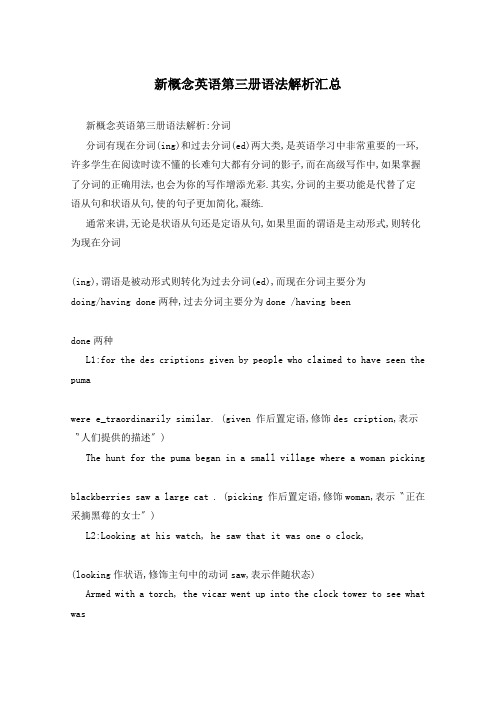
新概念英语第三册语法解析汇总新概念英语第三册语法解析:分词分词有现在分词(ing)和过去分词(ed)两大类,是英语学习中非常重要的一环,许多学生在阅读时读不懂的长难句大都有分词的影子,而在高级写作中,如果掌握了分词的正确用法,也会为你的写作增添光彩.其实,分词的主要功能是代替了定语从句和状语从句,使的句子更加简化,凝练.通常来讲,无论是状语从句还是定语从句,如果里面的谓语是主动形式,则转化为现在分词(ing),谓语是被动形式则转化为过去分词(ed),而现在分词主要分为doing/having done两种,过去分词主要分为done /having beendone两种L1:for the des criptions given by people who claimed to have seen the pumawere e_traordinarily similar. (given 作后置定语,修饰des cription,表示〝人们提供的描述〞)The hunt for the puma began in a small village where a woman pickingblackberries saw a large cat . (picking 作后置定语,修饰woman,表示〝正在采摘黑莓的女士〞)L2:Looking at his watch, he saw that it was one o clock,(looking作状语,修饰主句中的动词saw,表示伴随状态)Armed with a torch, the vicar went up into the clock tower to see what wasgoing on. (Armed作状语,由于be armed with形式所以采用过去分词,在句中作状语,修饰went up,表示伴随)L8: St. Bernard dogs have saved the lives of travellers crossing thedangerous Pass. (crossing 在这里作后置定语,修饰travellers,表示〝穿越关隘的游客〞)L_:even if he has five hundred gold watches hidden in hissuitcase.(hidden作后置定语,修饰)L_:Not wanting to frighten the poor man, Mrs. Richards quickly hid in thesmall storeroom under the stairs. (wanting的否定形式在这里作目的状语)L_:Then, squinting his eyes, he said: The light is dim. Read the letter tome .(squinting作伴随状语)L24: Dropping my suit, I dashed downstairs to tellGeorge.(dropping作伴随状语,说明和dash这个动作同时发生,突出当时的恐惧之情)关于分词的用法,新概念三册随处可见这样的例子,上面列举的句子也只是新三的皮毛而已,如果同学们对分词的用法感兴趣,或者想要把它牢牢掌握,可以找出新三中其他带有分词的句子逐一分析,相信一定会大有收获.新概念英语第三册语法解析:双重否定英文中的双重否定功能很多,很多同学认为双重否定有些啰嗦,表达的和肯定句是一样的,其实不然,双重否定句还有另外两个功能,即强调否定和委婉否定.第9课中描述猫的吸引力,原句:Cats never fail to fascinate human beings.其实这里的双重否定never failto 相当于英文中的always,不过更加突出强调了〝总是〞.比如我们表达对某道菜的喜爱,就可以利用这种方式:Sweet and Sour Pork neverfail to fascinate human beings.第26课中描述广告的吸引力,原句:No one can avoid being influenced by advertisements.作者在这里想强调的是人人都会受到广告的影响.在我们平时写作时,当描述一片美丽景色时,也利用这个句型,比如:No one can avoid beingtempted by the beauty of Shangri-la. 没有人能避免受到香格里拉美景的诱惑.第43课中描述〝常有的事〞,原句:It is not uncommon to hear that a shipping company has madea claim for cost of salvaging a sunken ship. 这里的notuncommon便是指的〝常有的事〞,类似的表达还有not illegal. not unavailable,not unusual等等.新概念英语第三册语法解析:冠词不定冠词〝a〞用来表示可数名词的单数形式,用于辅音音素前,an用于元音音素前.如:a person, a day; an hour, anold man...I.定冠词用法如下:(英语刚启蒙时你就知道冠词了,可你真正掌握了吗?再背一遍又何妨?!)1.用于双方都知道的名词前:Please cleanthe classroom.2.用于单数名词前,表示一类人或物:The horseis a useful animal.(马是有用的动物)This is a very hardjob for theteacher.(对于老师这是一项很难的工作.)3.用于世界上独一无二的东西前:the sun, the spring.4.用于方位名词前:People in the west like coffee very much.5.用于乐器名词前:play the violin.6.用于计量单位前:Gasoline is soldby the gallon.7.形容词级和序数词前:This is the easiest way to work out the problem. He came to see me for first time.8.用于江河湖海山脉名称前:the Pacific,the Thames,the Rocky Mountains9.杂志.报刊名称前:the Times,the Overseas Digest10.用于建筑物.和组织前:the White House, theMinistry of Education_.用于姓氏复数前,表〝某某夫妇,某某一家人〞the Smiths,the Greens_.用于形容词前,表一类人 / 物:the rich, theblind_.用于 English,Chinese,French等名词前,表〝全体国民〞the English,the ChineseII.以下情况不用冠词:1.三餐前 breakfast,lunch,supper, ... Have you had lunch?2.体育运动项目前 playchess,... I have nointerest intennis.3.在由 by引出的交通工具前by air(乘飞机),by car4.在称呼或职位前 He has been elected president of the committee.5.习惯用语前 at school,day by day,at table(在吃饭),go to church(做礼拜)...新概念英语第三册语法解析:易混淆的动词在学习英语动词时,一些初学者常碰到大量易混淆的同义词,下面就几组常用的动词加以比较.1. rise,raise,arise,arouse〝rise〞是不及物动词,过去式为rose,过去分词为risen,其基本词义〝上升,上涨〞.● The sun rises in the east.● A good idea r ose in my mind. 〝raise〞是及物规则动词,〝举起,提高〞.● He raised his voice to make himself heard.● The boy can raise the heavy stone.〝arise〞,是不及物动词,过去式为arose,过去分词arisen,其语义为〝出现,发生〞 .● His curiosity arose du e to the question his mother asked.〝arouse〞是及物动词,过去式和过去分词为aroused,其语义为〝唤醒,引起〞arouse somebody from sleep 把某人唤醒arouse suspicion 引起怀疑2. lay,lie,lie〝lay〞及物动词,〝放置,生蛋〞,过去式与过去分词为〝laid〞I ve laid the book on the self.The hen lays an egg every day.〝lie〞不及物动词〝位于,平躺〞,过去式为〝lay〞过去分词〝lain〞He lay on the floor and slept soundly.Beijing lies in the north of China.〝lie〞及物动词〝说谎〞,它是规则动词.He lied to his teacher.3. sit,seat〝sit〞不及物动词,过去式与过去分词均为〝sat〞.He sat in the classroom reading newspaper.〝seat〞及物动词,〝使就坐〞〝容纳〞.He seats himself here.He is seated there.He seats the baby on his knees.The hall will seat 5000 people.4. affect,effect〝affect〞及物动词,〝对……有影响,感动,触及〞The relations between then will be affected.〝effect〞及物动词, 〝导致,造成,带来(变化),产生〞The changes in methods effected some improvement in his study.5. hang (hanged, hanged) / (hung, hung)当 hang过去式与过去分词为〝hanged〞,其含义是〝绞死〞;而当hang的过去式与过去分词为〝hung〞时,其含义是〝悬挂〞.The man was hanged for murder. He hung his coat on the hook.6. borrow,lend 〝borrow〞借入〝borrow sth. from ...〞〝lend〞(lent, lent) 借出〝lend sb. sth〞或〝lend sth. To sb.〞 7. take,bring,fetch〝take〞(took, taken) 及物动词〝拿走〞新概念英语第三册语法解析:易混淆的动词(2)1. receive,accept〝receive〞客观上收到〝accept〞主观上愿意接受I received his gift, but I wouldn t like to accept it.2. fit, suit〝适合〞〝fit〞指〝尺寸〞的适合〝suit〞指〝款式,花样等〞的适合The dress doesn t fit me. It is too long.Blue is the color that suits her well.3. answer,reply 〝回答〞〝answer〞— vt. ; 〝reply〞— vi 须和〝to〞连用〝You needn t know it.〞 He answered.So far, they haven t answered / replied to our questions.4. spend, cost, take 〝花费〞〝spend〞 (spent, spent) 花〝时间,金钱〞主语须是人.He spend 5 hours writing the article.〝cost〞 (cost, cost) 花费〝金钱,时间,劳力〞可接双宾,主语须是〝物〞 The book cost me $20 and 2 days.〝take〞通常指花〝时间〞主语须是〝某种事情〞It takes me 20 minuter to go to school.The work took me longer than I e_pected.5. assure,ensure〝assure〞使放心 assure sb. of sth.assure sb. that...I can assure you of my honesty.〝ensure〞保证 ensure sth.(其后不能接人称)ensure thatensure doing sth.I can ensure his safety.He ensured that he finished the job in time.He ensured coming back later.百分重点:如ensure 含义为〝保护,使安全〞,其结构为:ensure sb from / against sth.He ensured the boy from drowning.新概念英语第三册语法解析汇总。
小升初英语语法讲义:动词(三)
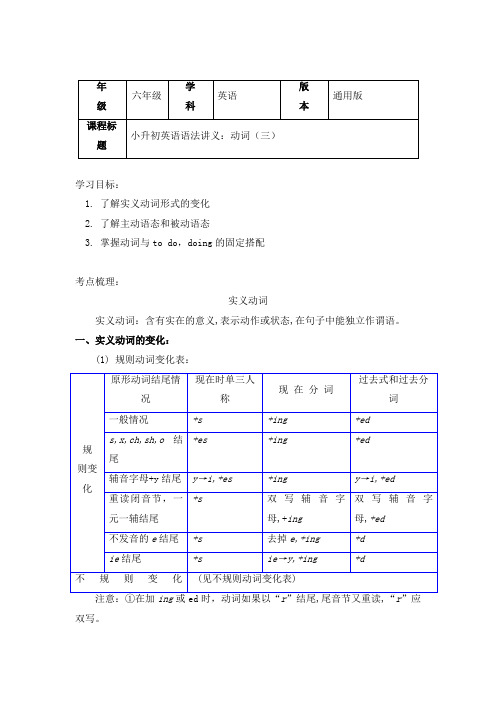
学习目标:1. 了解实义动词形式的变化2. 了解主动语态和被动语态3. 掌握动词与to do,doing的固定搭配考点梳理:实义动词实义动词:含有实在的意义,表示动作或状态,在句子中能独立作谓语。
一、实义动词的变化:(1) 规则动词变化表:双写。
②s/es的读音规则:在清辅音后读[s];在浊辅音和元音后读[z];在[ s ]、[ f]、[z]、[tf]、[dv]后读[iz]。
③ed的读音规则:在清辅音后读[t];在浊辅音和元音后读[d];在[t]、[d]后读[id]。
(2) 不规则动词变化表:( 原形→过去式→过去分词)二、主动语态和被动语态:(1) 主动语态如何改写为被动语态:主动句:主语(人/物) + 谓语(及物动词) + 宾语(人/物) + 其他(动作的执行者) (各种时态形式) (动作的承受者)被动句:主语(人/物) + 谓语(及物动词) + by +人/ 物+ 其他(2) 被动语态的用法:①不知道谁是动作的执行者(即不知道谁做)时用被动语态,省略by短语。
如:A man was killed in the accident.一个人死于事故。
This window was broken yesterday. 这扇窗子是昨天被打破的。
②不说或众所周知是谁做时,用被动语态,省略by短语。
如:Rice is also grown in this place.这个地方也种水稻。
A railroad will be built here in three years. 三年之后这里将要修建一条铁路。
③强调动作的承受者,句尾加by短语。
如:It was written by Lu Xun.它(书)是鲁迅写的。
A pet dog is never killed by its owner. 宠物狗是不会被主人宰杀的。
三、to do 与doing记住下面的固定搭配:Aask sb. to do sth. 要求某人做某事agree to do sth. 同意做某事allow sb. to do sth. 允许某人做某事(sb.)be allowed to do sth. (某人)被允许做某事Bbe interested in doing sth. 热衷于做某事be afraid to do sth. 害怕做某事=be afraid of doing sth.be busy doing sth. 忙于做某事Cconsider doing sth. 考虑做某事can't stand doing sth. 不能忍受做某事Ddo one's best to do sth. 尽某人最大努力去做某事do well in doing sth. 在某方面做得好decide to do sth. 决定做某事Eenjoy doing sth. 喜欢做某事Fforget to do sth. 忘记去做某事forget doing sth. 忘记已做过的事【比较】He forgot to turn off the light. 他忘了关灯。
职称英语语法知识指导:动词的-ed形式
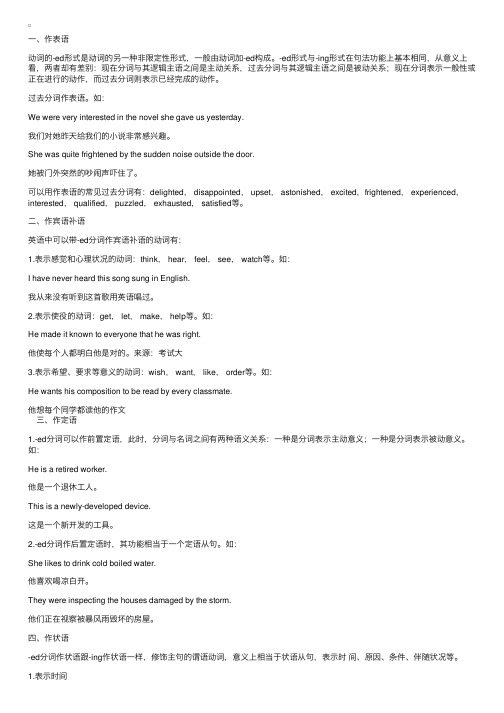
⼀、作表语动词的-ed形式是动词的另⼀种⾮限定性形式,⼀般由动词加-ed构成。
-ed形式与-ing形式在句法功能上基本相同,从意义上看,两者却有差别:现在分词与其逻辑主语之间是主动关系,过去分词与其逻辑主语之间是被动关系;现在分词表⽰⼀般性或正在进⾏的动作,⽽过去分词则表⽰已经完成的动作。
过去分词作表语。
如:We were very interested in the novel she gave us yesterday.我们对她昨天给我们的⼩说⾮常感兴趣。
She was quite frightened by the sudden noise outside the door.她被门外突然的吵闹声吓住了。
可以⽤作表语的常见过去分词有:delighted, disappointed, upset, astonished, excited,frightened, experienced,interested, qualified, puzzled, exhausted, satisfied等。
⼆、作宾语补语英语中可以带-ed分词作宾语补语的动词有:1.表⽰感觉和⼼理状况的动词:think, hear, feel, see, watch等。
如:I have never heard this song sung in English.我从来没有听到这⾸歌⽤英语唱过。
2.表⽰使役的动词:get, let, make, help等。
如:He made it known to everyone that he was right.他使每个⼈都明⽩他是对的。
来源:考试⼤3.表⽰希望、要求等意义的动词:wish, want, like, order等。
如:He wants his composition to be read by every classmate.他想每个同学都读他的作⽂ 三、作定语1.-ed分词可以作前置定语,此时,分词与名词之间有两种语义关系:⼀种是分词表⽰主动意义;⼀种是分词表⽰被动意义。
【免费】初中英语语法详解:形容词和副词的用法、动词的-ed分词
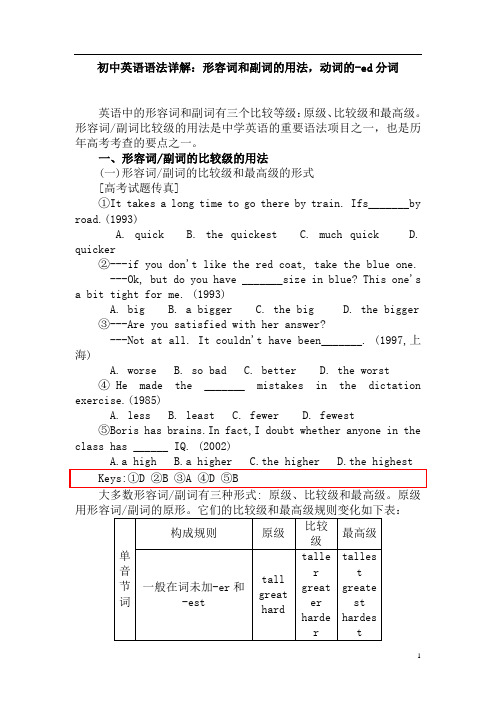
初中英语语法详解:形容词和副词的用法,动词的-ed分词英语中的形容词和副词有三个比较等级:原级、比较级和最高级。
形容词/副词比较级的用法是中学英语的重要语法项目之一,也是历年高考考查的要点之一。
一、形容词/副词的比较级的用法(一)形容词/副词的比较级和最高级的形式[高考试题传真]①It takes a long time to go there by train. Ifs_______by road.(1993)A. quickB. the quickestC. much quickD. quicker②---if you don't like the red coat, take the blue one.---Ok, but do you have _______size in blue? This one's a bit tight for me. (1993)A. bigB. a biggerC. the bigD. the bigger③---Are you satisfied with her answer?---Not at all. It couldn't have been_______. (1997,上海)A. worseB. so badC. betterD. the worst④He made the _______ mistakes in the dictation exercise.(1985)A. lessB. leastC. fewerD. fewest⑤Boris has brains.In fact,I doubt whether anyone in the class has ______ IQ. (2002)①John plays football________,if not better than,David.(1994)A.as wellB.as well asC.so wellD.so well as②She doesn't speak _______ her friends, but her written work is excellent. (1993)A. as well asB. as often asC. as much asD. as good as③The horse is getting old and cannot run _______ it did.(1988)A. as faster asB. so fast thanC. so faster asD. as fast as④Children shouldn't stay up _______ grown-ups do. (1988)A. as later asB. so late than词原级+as"结构。
- 1、下载文档前请自行甄别文档内容的完整性,平台不提供额外的编辑、内容补充、找答案等附加服务。
- 2、"仅部分预览"的文档,不可在线预览部分如存在完整性等问题,可反馈申请退款(可完整预览的文档不适用该条件!)。
- 3、如文档侵犯您的权益,请联系客服反馈,我们会尽快为您处理(人工客服工作时间:9:00-18:30)。
英语语法详解ed分词(三)
Her eyes filled with tears, she did not notice his ing.
18) This , we went out to play.
[A] was done[B] did[C] was dong[D] done
19) all his followers dead, the mander was taken by his enemy.
[A] For[B] As[C] Because of[D] With
1) B为正确答案。
空档前是一完整的句子,在没有连词的情况下,不能填充A和D;根据题意,"利息"是"通过…(被)挣来的",有被动之意,所以选B。
2) B为正确答案。
此句的意思是"房子"被"遗弃,没人住",是被动的意义,而A和C都不符合这一点。
D是动词不定式,一般表示将来或具体动作,所以D也不对。
3) D错。
应去掉多余的"is",使-ED分词"examined"作后置定
语修饰"object"。
C处并没有错。
"present"是形容词,它与后面的
成分构成形容词短语修饰限定前面的"the ratio…carbon"。
4) D为正确答案。
这句话前半句的-ED分词相当于一个时间状
语从句"When he was inaugurated a second time …",主句的主语应当是人,所以A和D为可能选项,但A中的look forward to后应跟名词,那么只有D为正确选项。
5) A为正确答案。
本句的意思是"在显微镜下看,雪花……",显然这里的看是"被观察"之义。
B、C、D都表示主动,A为正确选项。
6) A为正确答案。
(同上)
7) B为正确答案。
(同上)
8) D为正确答案。
四个选项中,只有D的主语为"John Singer Sargent"(人名) ,而只有人才能被"encouraged"(鼓舞),也就是说,只有D中的主语能充当空白前-ED分词短语的逻辑主语。
9) D为正确答案。
空白处只能用-ED分词才可和后面的"by"短语发生联系,并且其逻辑主语和主句主语一致。
10) D为正确答案。
本句的意思是"由于(被)写得急,……",所以A和C不对。
虽然B中的主语"plenty of errors"与"written"逻辑上可以呼应,但与"in the great haste"不一致。
"Written in great haste"的逻辑主语还是"the books"。
所以D正确。
11) D为正确答案。
从上下文看,空档处的主语应是表示要点的名词("as a city"),那么A不对;B和C都是一分句,而空档后是谓语部分,它们 __正确选项。
12) D为正确答案。
13) C为正确答案。
14) A 对。
本句的主语为pines(松树) ,这样就排除了B 选项,因为-ING分词表主动,而"松树"不可能是"找"(find)这个动作的逻辑主语,即动作发出者。
故只有A"found"(被发现) 的逻辑主语与"pines"一致,应选A。
15) D为正确答案。
16) A为正确答案。
空档前是-ED分词短语,空档处应是主谓俱全句,排除B和D。
从-ED分词短语中(Known for her …)可知,主句的主语是人而不是物,所以C也不对。
17) C为正确答案。
(同上)
18) D为正确答案。
A是不对的,如果we前加上and,才能选A。
19) D为正确答案。
内容仅供参考。
